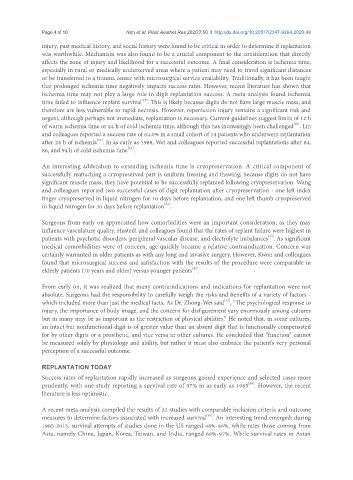Page 578 - Read Online
P. 578
Page 4 of 10 Noh et al. Plast Aesthet Res 2020;7:50 I http://dx.doi.org/10.20517/2347-9264.2020.49
injury, past medical history, and social history were found to be critical in order to determine if replantation
was worthwhile. Mechanism was also found to be a crucial component to the consideration that directly
affects the zone of injury and likelihood for a successful outcome. A final consideration is ischemia time,
especially in rural or medically underserved areas where a patient may need to travel significant distances
or be transferred to a trauma center with microsurgical service availability. Traditionally, it has been taught
that prolonged ischemia time negatively impacts success rates. However, recent literature has shown that
ischemia time may not play a large role in digit replantation success. A meta-analysis found ischemia
[19]
time failed to influence replant survival . This is likely because digits do not have large muscle mass, and
therefore are less vulnerable to rapid necrosis. However, reperfusion injury remains a significant risk and
urgent, although perhaps not immediate, replantation is necessary. Current guidelines suggest limits of 12 h
[20]
of warm ischemia time or 24 h of cold ischemia time, although this has increasingly been challenged . Lin
and colleagues reported a success rate of 64.0% in a small cohort of 14 patients who underwent replantation
[21]
after 24 h of ischemia . In as early as 1988, Wei and colleagues reported successful replantations after 84,
[22]
86, and 94 h of cold ischemia time .
An interesting addendum to extending ischemia time is cryopreservation. A critical component of
successfully reattaching a cryopreserved part is uniform freezing and thawing; because digits do not have
significant muscle mass, they have potential to be successfully replanted following cryopreservation. Wang
and colleagues reported two successful cases of digit replantation after cryopreservation - one left index
finger cryopreserved in liquid nitrogen for 10 days before replantation, and one left thumb cryopreserved
[23]
in liquid nitrogen for 30 days before replantation .
Surgeons from early on appreciated how comorbidities were an important consideration, as they may
influence vasculature quality. Hustedt and colleagues found that the rates of replant failure were highest in
[24]
patients with psychotic disorders, peripheral vascular disease, and electrolyte imbalances . As significant
medical comorbidities were of concern, age quickly became a relative contraindication. Concern was
certainly warranted in older patients as with any long and invasive surgery. However, Kwon and colleagues
found that microsurgical success and satisfaction with the results of the procedure were comparable in
[25]
elderly patients (70 years and older) versus younger patients .
From early on, it was realized that many contraindications and indications for replantation were not
absolute. Surgeons had the responsibility to carefully weigh the risks and benefits of a variety of factors -
[13]
which included more than just the medical facts. As Dr. Zhong-Wei said , “The psychological response to
injury, the importance of body image, and the concern for disfigurement vary enormously among cultures
but in many may be as important as the restriction of physical abilities.” He noted that, in some cultures,
an intact but nonfunctional digit is of greater value than an absent digit that is functionally compensated
for by other digits or a prosthetic, and vice versa in other cultures. He concluded that “function” cannot
be measured solely by physiology and ability, but rather it must also embrace the patient’s very personal
perception of a successful outcome.
REPLANTATION TODAY
Success rates of replantation rapidly increased as surgeons gained experience and selected cases more
[26]
prudently, with one study reporting a survival rate of 97% in as early as 1985 . However, the recent
literature is less optimistic.
A recent meta-analysis compiled the results of 32 studies with comparable inclusion criteria and outcome
measures to determine factors associated with increased survival . An interesting trend emerged: during
[19]
1985-2015, survival attempts of studies done in the US ranged 48%-86%, while rates those coming from
Asia, namely China, Japan, Korea, Taiwan, and India, ranged 68%-97%. While survival rates in Asian

